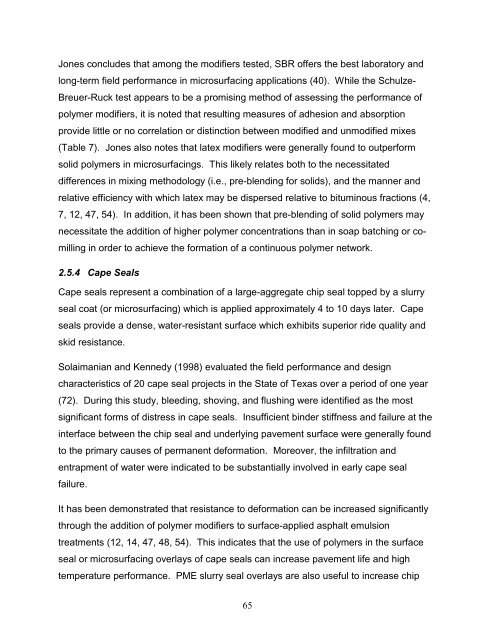Using Polymer Modified Asphalt Emulsions in Surface Treatments A ...
Using Polymer Modified Asphalt Emulsions in Surface Treatments A ...
Using Polymer Modified Asphalt Emulsions in Surface Treatments A ...
You also want an ePaper? Increase the reach of your titles
YUMPU automatically turns print PDFs into web optimized ePapers that Google loves.
Jones concludes that among the modifiers tested, SBR offers the best laboratory and<br />
long-term field performance <strong>in</strong> microsurfac<strong>in</strong>g applications (40). While the Schulze-<br />
Breuer-Ruck test appears to be a promis<strong>in</strong>g method of assess<strong>in</strong>g the performance of<br />
polymer modifiers, it is noted that result<strong>in</strong>g measures of adhesion and absorption<br />
provide little or no correlation or dist<strong>in</strong>ction between modified and unmodified mixes<br />
(Table 7). Jones also notes that latex modifiers were generally found to outperform<br />
solid polymers <strong>in</strong> microsurfac<strong>in</strong>gs. This likely relates both to the necessitated<br />
differences <strong>in</strong> mix<strong>in</strong>g methodology (i.e., pre-blend<strong>in</strong>g for solids), and the manner and<br />
relative efficiency with which latex may be dispersed relative to bitum<strong>in</strong>ous fractions (4,<br />
7, 12, 47, 54). In addition, it has been shown that pre-blend<strong>in</strong>g of solid polymers may<br />
necessitate the addition of higher polymer concentrations than <strong>in</strong> soap batch<strong>in</strong>g or comill<strong>in</strong>g<br />
<strong>in</strong> order to achieve the formation of a cont<strong>in</strong>uous polymer network.<br />
2.5.4 Cape Seals<br />
Cape seals represent a comb<strong>in</strong>ation of a large-aggregate chip seal topped by a slurry<br />
seal coat (or microsurfac<strong>in</strong>g) which is applied approximately 4 to 10 days later. Cape<br />
seals provide a dense, water-resistant surface which exhibits superior ride quality and<br />
skid resistance.<br />
Solaimanian and Kennedy (1998) evaluated the field performance and design<br />
characteristics of 20 cape seal projects <strong>in</strong> the State of Texas over a period of one year<br />
(72). Dur<strong>in</strong>g this study, bleed<strong>in</strong>g, shov<strong>in</strong>g, and flush<strong>in</strong>g were identified as the most<br />
significant forms of distress <strong>in</strong> cape seals. Insufficient b<strong>in</strong>der stiffness and failure at the<br />
<strong>in</strong>terface between the chip seal and underly<strong>in</strong>g pavement surface were generally found<br />
to the primary causes of permanent deformation. Moreover, the <strong>in</strong>filtration and<br />
entrapment of water were <strong>in</strong>dicated to be substantially <strong>in</strong>volved <strong>in</strong> early cape seal<br />
failure.<br />
It has been demonstrated that resistance to deformation can be <strong>in</strong>creased significantly<br />
through the addition of polymer modifiers to surface-applied asphalt emulsion<br />
treatments (12, 14, 47, 48, 54). This <strong>in</strong>dicates that the use of polymers <strong>in</strong> the surface<br />
seal or microsurfac<strong>in</strong>g overlays of cape seals can <strong>in</strong>crease pavement life and high<br />
temperature performance. PME slurry seal overlays are also useful to <strong>in</strong>crease chip<br />
65
















